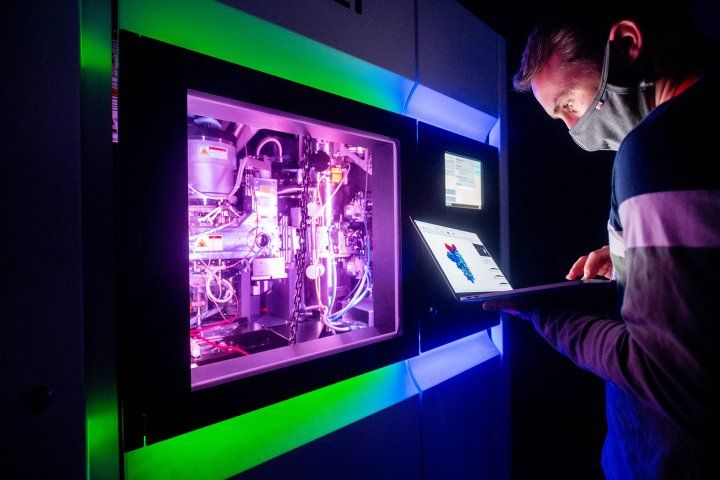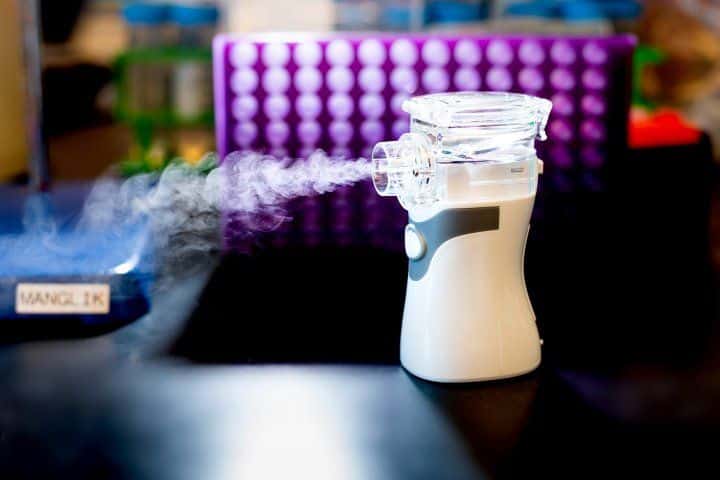While waiting for vaccines for Covid-19 (the first batch of the Russian one in two weeks), scientists at UC San Francisco are developing a new approach to stop the spread of the virus.
A team of researchers led by Michael Schoof has designed synthetic, production-ready nanobodies that break down the SARS-CoV-2 mechanism that allows the virus to infect our cells. In an aerosol formulation they tested, dubbed “AeroNabs” by the researchers, these molecules could be self-administered with a nasal spray or inhaler.
As reported in a new document, now available on the bioRxiv prepress server, in vivo experiments show that the molecule is among the most potent SARS-CoV-2 antivirals discovered so far.

AeroNabs, a mask to inhale
Used once a day, AeroNabs could provide powerful and reliable protection against SARS-CoV-2 until a vaccine is available.
The research team is already actively discussing with business partners to increase AeroNabs production and clinical testing. If these tests are successful, the scientists aim to make AeroNabs widely available as an affordable over-the-counter drug to prevent and treat Covid-19.
It is much more effective than masks. AeroNabs is a molecular form of personal protective equipment that can act as an important buffer until vaccines provide a permanent solution to Covid-19
Peter Walter, co-inventor of AeroNabs, PhD, professor of biochemistry and biophysics at UCSF, and Howard Hughes Medical Institute investigator.
AeroNabs could be a permanent line of defense even for those who cannot access or do not respond to SARS-CoV-2 vaccines. With a simple nasal spray they would avoid the problem.
Design inspired by the nanobodies of the llamas
Though designed entirely in the laboratory, the AeroNabs were inspired by nanocorphs, antibody-like immune proteins found naturally in llamas, camels and related animals.
Since their discovery in a Belgian laboratory in the late 80s, the distinctive properties of nanobodies have intrigued scientists around the world.
“Although they function very similarly to antibodies found in the human immune system, nanobodies offer a number of unique advantages for effective therapies against SARS-CoV-2.” This is what the co-inventor says Aashish Manglik, MD, PhD, assistant professor of pharmaceutical chemistry who frequently employs nanobodies as a tool in his research on the structure and function of proteins that send and receive signals across the cell membrane.

The advantages of nanobodies
For starters, nanobodies are an order of magnitude smaller than human antibodies, which makes them easier to manipulate and modify in the laboratory.
Their small size and relatively simple structure also make them significantly more stable than antibodies from other mammals. Furthermore, unlike human antibodies, nanocods can be mass-produced simply and economically: Scientists insert the genes that contain the molecular blueprints to build the nanobodies in E. coli or yeast and turn these microbes into factories of high-yield nanobodies. The same method has been used safely for decades to mass produce insulin.
Manglik states that “nanobodies were just the starting point for us. Although already very performing, we thought we could improve them through protein engineering. This ultimately led to the development of AeroNabs”
The Spike protein is key to infection
SARS-CoV-2 relies on its so-called spike proteins to infect cells. These proteins dot the surface of the virus and give it a crown-like appearance when viewed through an electron microscope (hence the name “coronavirus "). The spikes, however, are more than just decoration - they are the essential key that allows the virus to enter our cells.

Like a retractable tool, the tips can go from a closed, inactive state to an open, active state. When any of the approximately 25 “pins” of a viral particle become active, the three “receptor-binding domains” or RBDs of that “pin” are exposed and are ready to bind to ACE2, a receptor found on human cells.
The UCSF researchers believed that if they could find nanobodies that prevent spike-ACE2 interactions, they would prevent the virus from infecting cells.
To find effective candidates, the scientists analyzed over 2 billion synthetic nanocods. After successive rounds of testing, the team reduced the candidates to 21 nanocods capable of preventing the spike protein from interacting with ACE2.
Veronica Rezelj, PhD, virologist in the laboratory of Marco Vignuzzi, PhD, at the Institut Pasteur in Paris, tested the three most promising nanobodies against live SARS-CoV-2 and found that the nanobodies are extraordinarily potent, preventing infection even at low doses.
Wrap the “keys” and prevent them from entering the “lock”.
The most potent of these nanobodies, however, not only acts as a sheath on RBDs, but also as a molecular mouse trap, locking spikes in its closed, inactive state, and preventing it from interacting with ACE2. It was the genesis of the AeroNabs.

The tests and the results: an immeasurable power
In a separate set of experiments, the team designed a molecular chain that could link three nanobodies together. The outcome? Amazing. The three nanobodies together are 200.000 times more powerful than a single nanobody.
And when they evaluated the results, they found that they were off the charts. “It was so effective,” Walter says, “that it surpassed our ability to measure its potency.”
Easy to administer
In a final set of experiments, the researchers subjected the nanobodies to a series of stress tests, subjecting them to high temperatures, turning them into a shelf-stable powder, and producing an aerosol.
Each of these processes is highly damaging to most proteins, but scientists confirmed that, thanks to the inherent stability of the nanobodies, there was no loss of antiviral potency.
Especially in the aerosol form, which makes AeroNabs a potent SARS-CoV-2 antiviral that is practical to administer with an inhaler or nasal spray.
AeroNabs, a daily spray of a nasal spray keeps Covid away
“We're not the only ones who think AeroNabs are an amazing technology,” says Manglik. “Our team is in contact with potential commercial partners interested in the production and distribution of AeroNabs and we hope to begin human trials soon.”


